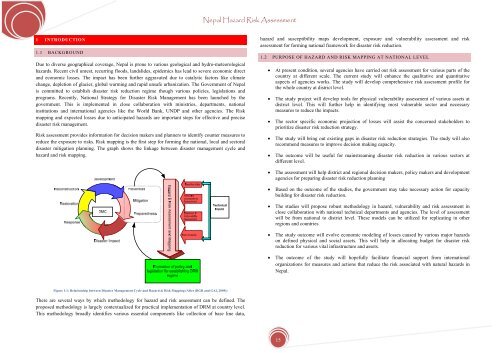Nepal Hazard Risk Assessment - Asia-Pacific Gateway for Disaster ...
Nepal Hazard Risk Assessment - Asia-Pacific Gateway for Disaster ...
Nepal Hazard Risk Assessment - Asia-Pacific Gateway for Disaster ...
Create successful ePaper yourself
Turn your PDF publications into a flip-book with our unique Google optimized e-Paper software.
<strong>Nepal</strong> <strong>Hazard</strong> <strong>Risk</strong> <strong>Assessment</strong><br />
1 INTRODUCTION<br />
1.1 BACKGROUND<br />
Due to diverse geographical coverage, <strong>Nepal</strong> is prone to various geological and hydro-meteorological<br />
hazards. Recent civil unrest, recurring floods, landslides, epidemics has lead to severe economic direct<br />
and economic losses. The impact has been further aggravated due to catalytic factors like climate<br />
change, depletion of glacier, global warming and rapid unsafe urbanization. The Government of <strong>Nepal</strong><br />
is committed to establish disaster risk reduction regime though various policies, legislations and<br />
programs. Recently, National Strategy <strong>for</strong> <strong>Disaster</strong> <strong>Risk</strong> Management has been launched by the<br />
government. This is implemented in close collaboration with ministries, departments, national<br />
institutions and international agencies like the World Bank, UNDP and other agencies. The <strong>Risk</strong><br />
mapping and expected losses due to anticipated hazards are important steps <strong>for</strong> effective and precise<br />
disaster risk management.<br />
<strong>Risk</strong> assessment provides in<strong>for</strong>mation <strong>for</strong> decision makers and planners to identify counter measures to<br />
reduce the exposure to risks. <strong>Risk</strong> mapping is the first step <strong>for</strong> <strong>for</strong>ming the national, local and sectoral<br />
disaster mitigation planning. The graph shows the linkage between disaster management cycle and<br />
hazard and risk mapping.<br />
hazard and susceptibility maps development, exposure and vulnerability assessment and risk<br />
assessment <strong>for</strong> <strong>for</strong>ming national framework <strong>for</strong> disaster risk reduction.<br />
1.2 PURPOSE OF HAZARD AND RISK MAPPING AT NATIONAL LEVEL<br />
• At present condition, several agencies have carried out risk assessment <strong>for</strong> various parts of the<br />
country at different scale. The current study will enhance the qualitative and quantitative<br />
aspects of agencies works. The study will develop comprehensive risk assessment profile <strong>for</strong><br />
the whole country at district level.<br />
• The study project will develop tools <strong>for</strong> physical vulnerability assessment of various assets at<br />
district level. This will further help in identifying most vulnerable sector and necessary<br />
measures to reduce the impacts.<br />
• The sector specific economic projection of losses will assist the concerned stakeholders to<br />
prioritize disaster risk reduction strategy.<br />
• The study will bring out existing gaps in disaster risk reduction strategies. The study will also<br />
recommend measures to improve decision making capacity.<br />
• The outcome will be useful <strong>for</strong> mainstreaming disaster risk reduction in various sectors at<br />
different level.<br />
• The assessment will help district and regional decision makers, policy makers and development<br />
agencies <strong>for</strong> preparing disaster risk reduction planning<br />
• Based on the outcome of the studies, the government may take necessary action <strong>for</strong> capacity<br />
building <strong>for</strong> disaster risk reduction.<br />
• The studies will propose robust methodology in hazard, vulnerability and risk assessment in<br />
close collaboration with national technical departments and agencies. The level of assessment<br />
will be from national to district level. These models can be utilized <strong>for</strong> replicating in other<br />
regions and countries<br />
• The study outcome will evolve economic modeling of losses caused by various major hazards<br />
on defined physical and social assets. This will help in allocating budget <strong>for</strong> disaster risk<br />
reduction <strong>for</strong> various vital infrastructure and assets.<br />
• The outcome of the study will hopefully facilitate financial support from international<br />
organizations <strong>for</strong> measures and actions that reduce the risk associated with natural hazards in<br />
<strong>Nepal</strong>.<br />
Figure 1.1: Relationship between <strong>Disaster</strong> Management Cycle and <strong>Hazard</strong> & <strong>Risk</strong> Mapping (After (BGR and GAI, 2009))<br />
There are several ways by which methodology <strong>for</strong> hazard and risk assessment can be defined. The<br />
proposed methodology is largely contextualized <strong>for</strong> practical implementation of DRM at country level.<br />
This methodology broadly identifies various essential components like collection of base line data,<br />
15
















